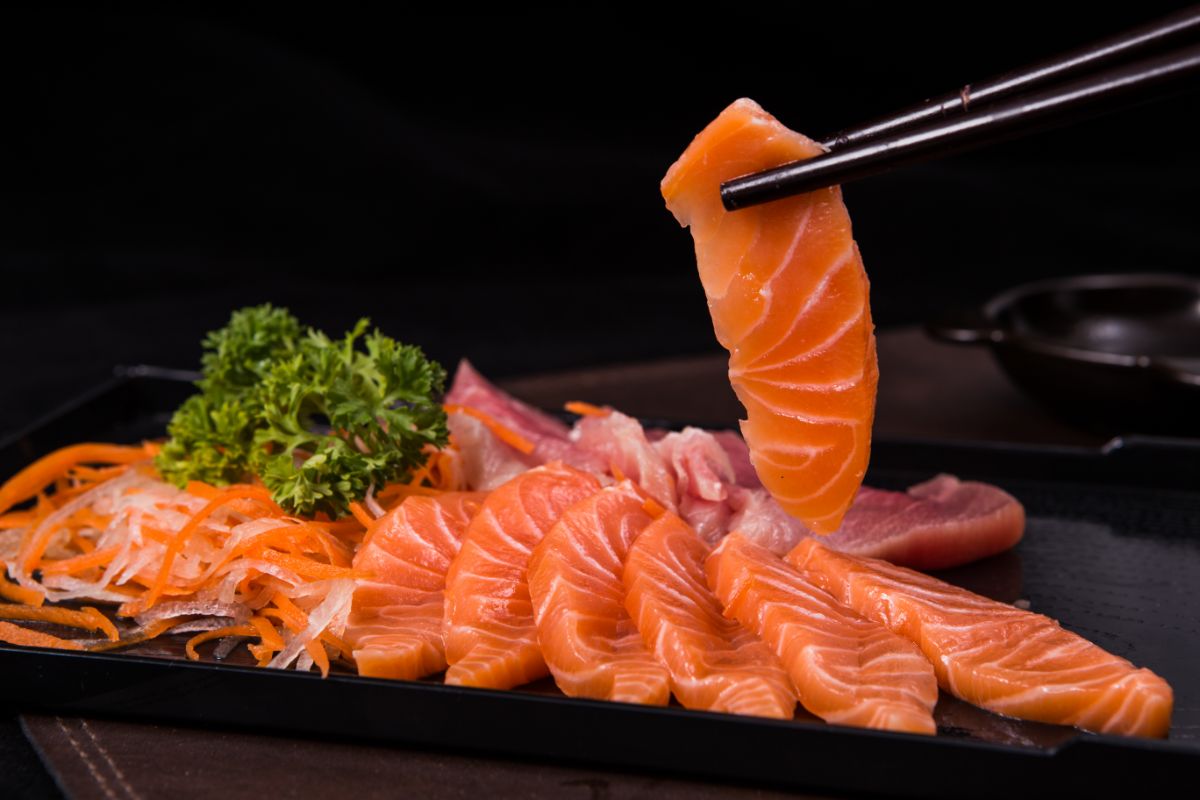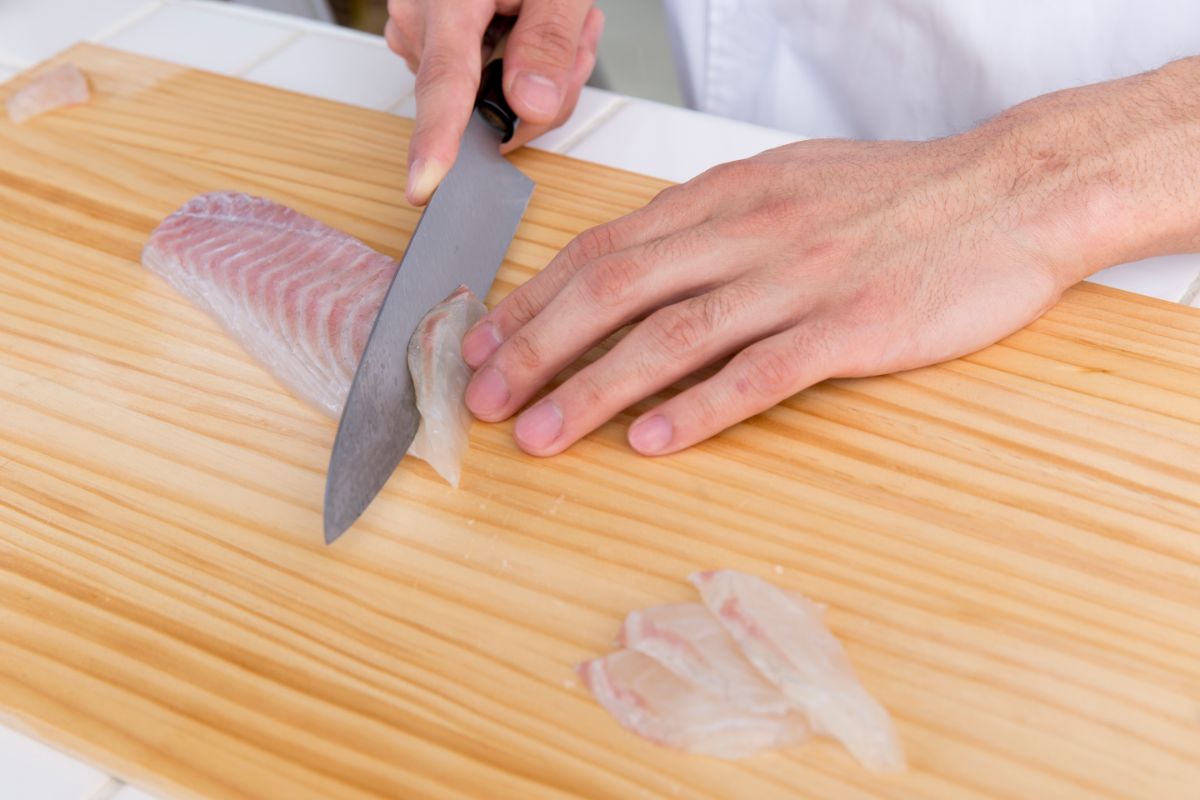Sashimi is often confused with other Japanese dishes, specifically sushi and negri. While the former involves rice, fish, and several other ingredients, the latter involves seasoned rice balls with a piece of raw fish over the top.
Sashimi is even easier and it may be surprising to learn that rice is not involved as a piece of raw fish is typically laid over a piece of the Japanese radish known as daikon.

A lot of skill and expertise are required to present sashimi and that begins with knowing what it is.
Once you have chosen your fillet of fish, you should know how to cut sashimi.
What Is Considered Sashimi?
Sashimi is one of the most beloved traditional dishes to come from Japan. The official classification for sashimi is that it is raw meat that is served in bite-sized pieces or thinly sliced.
Sashimi can be made from several types of meat including deer, beef, chicken, and tofu skin though seafood sashimi is its most popular variation.
Globally, you are more likely to see salmon (also known as sake when in Japan) used for sashimi than any other meat.
The Japanese believe that pretty much any fish that can be caught can then be eaten raw as sashimi. That includes salmon, tuna, and kingfish but even pufferfish (blowfish) which was featured in an episode of The Simpsons.
To create sashimi from pufferfish for commercial purposes, you do require a specific license to simply dissect it.
Whichever fish you decide to use, the best sashimi is typically from freshly caught fish from the sea which is filleted then sliced, and served in front of you.
One crucial difference between sashimi and sushi is that sashimi is not served with rice. You can expect to find a garnish with your sashimi and a common one is daikon radish which has been grated or shredded.
Why Is Salmon So Popular For Sashimi?
There are several reasons why salmon is so popular for sashimi, beyond the two words sharing the same first two letters making it seem like an ideal pairing.
Salmon can be thinly sliced when raw easier than some meats and is also full of health benefits as a high-grade fish.
As well as large amounts of Omega-3 fatty acids, the fish also contains selenium, vitamin D, and plenty of other vitamins too.
Both customers and chefs enjoy toro-salmon which is the ridiculously delicious fatty part of the fish.
How To Achieve Great Sashimi
The first step to achieving great sashimi is to get hold of a suitable fish. This may be simple enough in Japan where supermarkets and fish shops have fish that are deemed sashimi-quality and are readily available.
Outside of Japan, even in the biggest fish markets, you might struggle to find a suitable fish of high enough quality. Even then, the choice may be limited so you might have to make do with a less popular fish.
Choose a fillet of fish that is farmed (so it is free from parasites) and is over the width of four fingers. You can also determine the freshness of the fish by checking that its eyes are clear, that the gills are bright red, and the flesh is firm.
Clean, scale, and gut the fish using a fish tweezers, a fish scaler, and a boning knife though the fish market may be able to do this for you.
How To Cut Sashimi

Before you even begin to grab a knife, you should examine the fillet of fish. The direction of grains is of crucial importance as the fillets need to be cut perpendicular to the spine’s direction.
Effectively, you cut the fillet across the grain which ensures that the sashimi will not be stringy.
If the fish fillet is a long and narrow block then this can be easy as it can be ready to slice quickly after you have given it a quick look but that can become harder if the fillet is not a long block.
Prepare your work surface by wiping it down with a bleach solution (typically a tablespoon of bleach with a gallon of water) then dry it with a cloth.
When you are ready to slice your fish, ensure that the knife is decidedly sharp and use a bleach solution to fully disinfect it.
For sashimi, you need to cut the fish into strips that measure a single inch (2.5 cm). Each strip can be diced into cubes that measure three-quarters of an inch (19 mm).
Final Thoughts
Once you have selected your piece of fish, it is crucial that you prepare it properly by running it under cold water and then patting it dry.
If the fish fillet is from a less than fresh fish then that will come through in the sashimi so choose well.
A sanitized work surface and knives are essential to prevent contamination but after the fish is prepared there is only one choice to make. Choose the cutting technique that you want as it can take a while to learn a new technique.
Frequently Asked Questions
What Are The Different Cutting Techniques Of Sashimi?
Hira-Zukuri is likely the most popular cutting technique for sashimi and is ideal for oily, flavorful fish. This technique will provide rectangular slices of fresh, raw fish which typically measure around a single centimeter in thickness.
Another cutting technique is Kaku-Zukuri which produces cubes or squares of fish that are around two centimeters in length for each side.
A difficult cutting technique for sashimi is known as Usu-Zukuri which involves cutting the fish into wafer-thin rectangular pieces which are so thin as to be nearly see-through.
This is an ideal cutting technique for a white fish such as the ideally named whitefish which are firmer in general. Then there is Iki-Zukuri which is likely the most difficult as the fish is cut while it is still alive to minimize cross-contamination.
Why Do You Have To Cut Across The Grain For Sashimi?
Cutting across the grain prevents the fish from falling apart and provides stringy pieces of fish. This method also provides better texture and only short fibers are in each slice.
If you enjoyed this post, you might enjoy our article on ‘How To Store Mochi‘.
- 16 Best Websites To Watch Japanese Movies With English Subtitles - May 11, 2023
- Is ZIPAIR The Best Airline For Traveling To Japan? - May 11, 2023
- Ryu Murakami Vs Haruki Murakami – Which One Should You Read? - May 11, 2023



![How Many Types Of Sushi Are There? [Definitive Guide] How Many Types Of Sushi Are There? [Definitive Guide]](https://justaboutjapan.com/wp-content/uploads/2023/05/How-Many-Types-Of-Sushi-Are-There-Definitive-Guide-150x150.jpg)

![What Sushi Has No Fish? [Vegetarian Sushi Explained] What Sushi Has No Fish? [Vegetarian Sushi Explained]](https://justaboutjapan.com/wp-content/uploads/2023/03/What-Sushi-Has-No-Fish-Vegetarian-Sushi-Explained-150x150.jpg)

